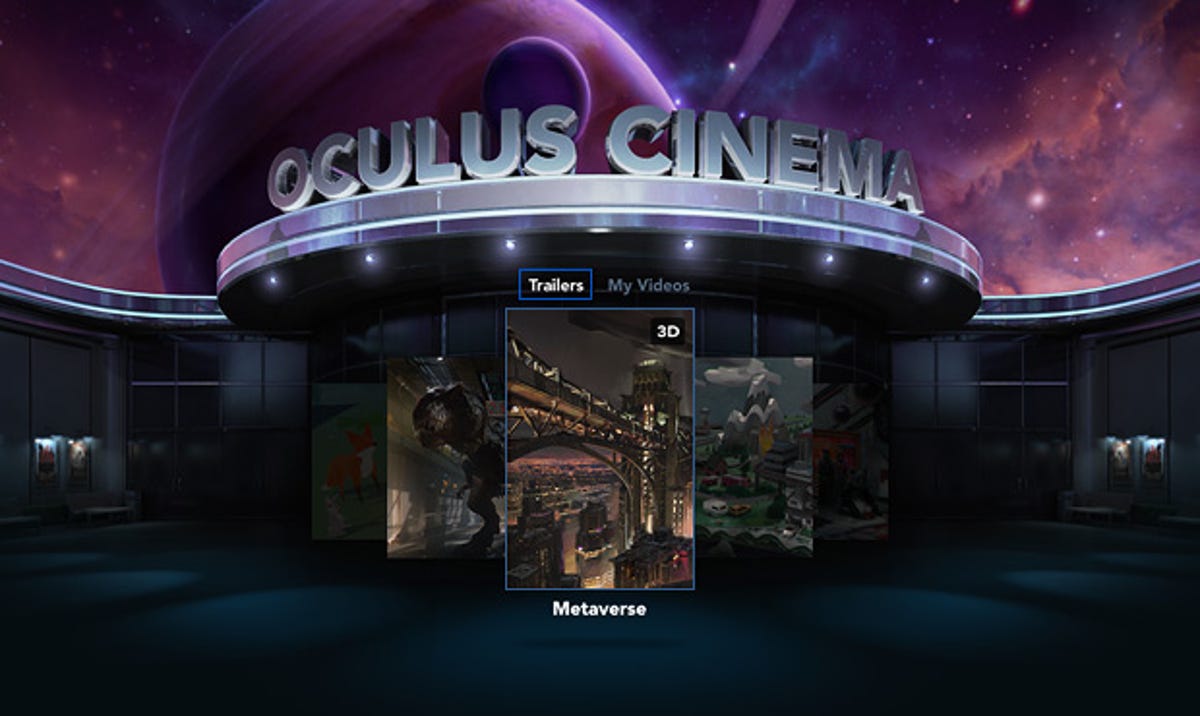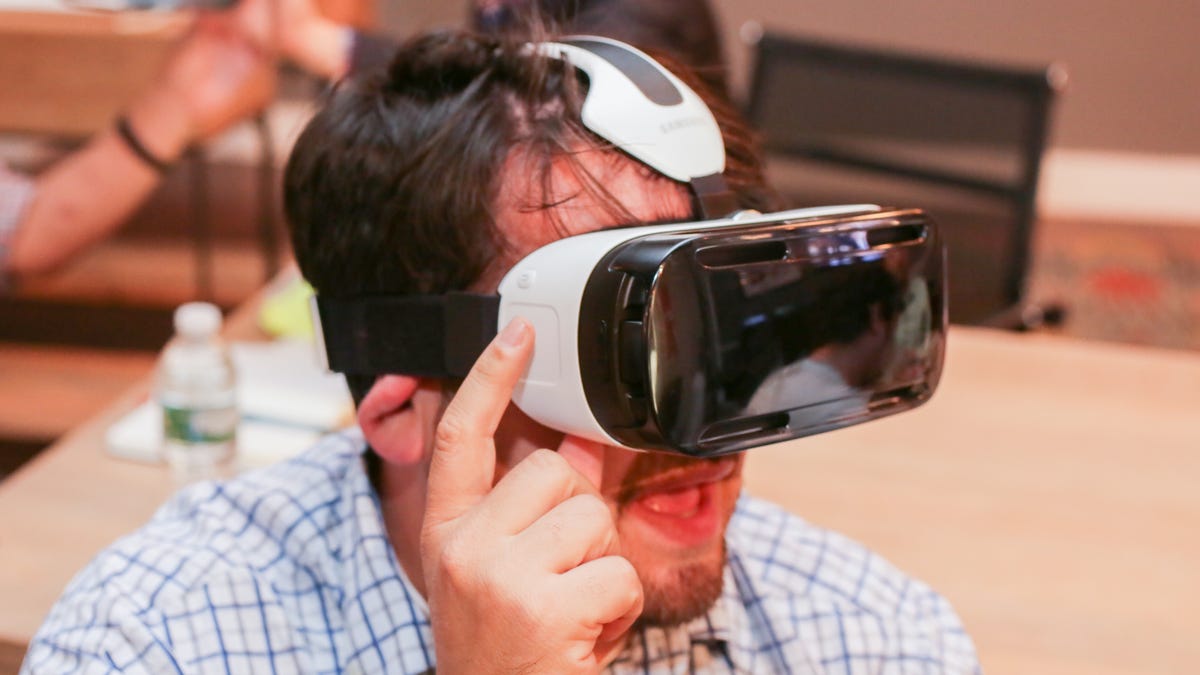
Oculus
Virtual reality can transport you to distant space to participate in an epic starship battle, or it can drop you in the ocean, with sharks swimming all around.
But its biggest act yet may be showing you a plain old movie.
For the past two years, developers large and small have been toiling away hoping to create the app that becomes synonymous with VR and helps the technology really take off — its “killer app,” as it’s called.
That may have already happened, and it isn’t a game, a panoramic photo application or a calming simulation of a beach scene; it’s movies. As VR technology begins its march to store shelves, manufacturers like Oculus are recognizing the potential for their immersive technologies to deliver the works of Hollywood.
When Oculus first unveiled its headset two years ago, it was pitched as a next-generation video game device. Companies such as Samsung and Sony have since joined in , funding new development for the burgeoning technology. But to make the device succeed, it needs to appeal to more than just gamers. And that’s where movies comes in.
“The key to mainstream consumer adoption is going to be enough immersive content on a continual basis that people will be coming back for,” said Jens Christensen, head of virtual reality camera maker Jaunt. Imagine being on an airplane, staring at a movie on the screen of a tablet or on a tinier display installed in the seat in front of you, he said.
Now, consider putting on a virtual reality headset instead. “You suddenly get a 20-foot screen in front of your face–it’s a virtual screen, but it’s huge, and it’s a big difference,” he said.
We’ve been here before
VR wouldn’t be the first time the consumer electronics industry tried to get people to jump to a new video technology; it last tried with televisions that could display three-dimensional images.
Those TVs were able to display 3D video by showing two slightly different angles for an image on the screen at once, a technique that was popularized after the movie “Avatar” became one of the highest grossing films ever in 2009. Soon movies, a couple television channels and even some video games worked with these devices.
But 3D never really caught on with consumers. Analysts mostly blamed the glasses users had to wear in order for the effect to work; they were sometimes expensive accessories that always looked goofy and were uncomfortable to wear.
Looking at Oculus
- Oculus closer to launch with new virtual reality headset
- How do you make a good virtual reality game? Oculus developers meet to find out
- Virtual momentum: Newest Oculus prototype triples daily sales
- Samsung could give virtual reality the kick in the pants it needs
- Oculus to get hands on with new virtual reality gear
When companies began working on virtual reality, some became worried that the technology would have another pitfall similar to 3D televisions: Users could get headaches if they looked at the 3D effect for too long. Samsung, which will launch its Gear VR headset later this fall, expects consumers at first to use the device for short sessions at a time, typically less than an hour — long enough for brief, more immersive videos and a few rounds in a game.
But what about movies, some of which can last nearly three hours?
Samsung hopes consumers will spend more and more time on the device as they get used to it and as the platform offers more games and programming. A study Samsung conducted revealed that many users were comfortable wearing VR goggles for two hours or longer. That research helped convince longtime Samsung video partner M-GO to build a movie app for the Gear VR.
“Here you are in an environment that’s even more immersive than 3D was,” said Arnaud Retureau, vice president of product for M-GO. “We were a bit concerned initially, and we were thinking about [offering only] trailers or short content.”
The initial version of M-GO’s VR app, called M-GO Advanced, will simply allow users to browse video titles and watch trailers by visiting “rooms” of a house for different genres and categories. But the company plans to launch a full video store by the end of the year, Retureau said.
A movie theater experience
Oculus, the VR headset company Facebook agreed to purchase for $2 billion in March, has built its own video watching program as well. This app, called Oculus Cinema, is intended to both show movies and also help users get comfortable watching the screen for hours at a time.
To do this, the cinema app puts users in the middle of a movie theater — that perfect middle seat almost no one ever gets in the real world. Look around and you see rows of seats and walls, just like you would inside a movie theater. The movie plays on a simulated screen, with the light bouncing off the seats in the audience, just as it would in the real world.
Users can choose their theater, ranging from a standard one to a simulated home theater to an IMAX-sized screen, which appears large but is actually being simulated on a piece of glass that fits in your palm. There’s even a movie theater on the moon, complete with light bouncing off the rocks to your left, or the Apollo lander to your right.
The technology could also go further. Right now, the seats within the theatre are empty, but the people at Oculus imagine an experience where a friend or family member watching the same video even from the other side of the world could digitally sit next to you, giving people an opportunity to experience the social aspect of watching movies as well. Or users could watch the Dreamworks movie “Madagascar,” with characters from the movie sitting in the theater, right next to you.
For Oculus, this is more than just a hobby. The company has devoted a few engineers and a product manager to the effort and wants to inspire others, said Max Cohen, head of mobile efforts at Oculus who worked on the Gear VR. “Our goal is to seed the ecosystem with the ability to take existing content and movies and put it into nice VR environment.”
While many Hollywood companies have begun researching VR with high-profile demonstrations, and eventual full feature films directed by industry heavyweights, it’s unclear how many studios are willing to repurpose their catalogs of videos for VR. Online video services Netflix and Hulu haven’t signaled plans to jump into VR yet either.
What’s known so far is that the technology used to display traditional video on a VR headset isn’t much different from streaming it on a TV or a tablet. In the case of Samsung’s Gear VR, made along with Oculus, the device’s screen and brain is actually a Galaxy Note 4 smartphone.
Licensing also doesn’t seem to be much trouble. M-GO said it didn’t have to change any of its licensing deals with content providers. Other video providers may be able to follow a similar path.


Sarah Tew
Making movies work
Some of the work that still needs to be done, however, is on the devices themselves. Component suppliers in particular are making sure their chips are well suited for the task.
Qualcomm worked with Samsung to make the Gear VR feel more immersive. Qualcomm’s chips power the Note 4 in the Gear VR, and it has built special capabilities into its processors that track motion by interacting with sensors in people’s headsets. This helps images display more quickly and reduce the likelihood of motion sickness and lagging images.
Qualcomm also is researching better sensors that can more accurately detect motion without requiring much power, as well as “immersive” surround sound. “We’re really at the point where many of those technologies are very close to where they need to be to come together,” said Jay Wright, Qualcomm vice president of product management.
His group has worked with Samsung and Oculus to provide augmented reality for VR headsets — technology that would allow users to see how large a TV would look in a home or help medical students visualize a procedure overlaid on top of a fake body part.
What’s next for VR movies?
Movie makers ranging from startups to established studios are working on the next wave of virtual reality products.
Chief among these companies are hardware makers, designing cameras that can capture video in a full sphere, allowing someone wearing a virtual reality headset to literally sit in the middle of a film as it’s happening or navigate around a sports stadium as a football game progresses. “Once you’ve experienced fully-immersive content, that’s really what you want,” said Jaunt’s Christensen. Over time, he said, customers will look at normal movies and say, “Where’s the rest?”
In September, when Samsung and Oculus announced the Gear VR headset, it demonstrated putting a viewer in the middle of a performance of Cirque du Soleil, as well as a Coldplay concert. “This is going to top anything you’ve ever experienced or expected,” Rory O’Neill, a Samsung marketing executive, said as he showed off the Gear VR at the announcement in Berlin. “Virtual reality allows us to extend the way we look, we see and can experience content. We can be there — wherever there is.”
The biggest limitation for these types of videos is how new they are. Cameras are still being created to capture 360-degree views. But technology experts say fully immersive video experiences will eventually become commonplace.
Manufacturers are already dreaming of consumer devices that can be placed on a table, and capture the world around them. “The entertainment factor of capturing a sporting event, viewing a wedding and other lifestyle experiences,” said Sean Ramsay, head of Bubl Technology, a spherical camera maker aiming products at both businesses and consumers. “We can recreate it so you feel like you’re there.”
Videos that make people feel like they’re part of an event or video instead of just watching from the sidelines will draw consumers away from choosing a standard box-format movie, Christensen said.
“Certainly, if they could choose between a rectangle and fully immersive, I think they would choose fully immersive,” he said.
CNET’s Joan E. Solsman contributed to this report.




